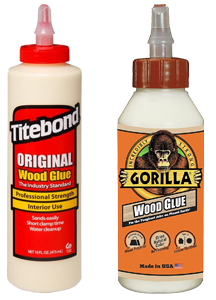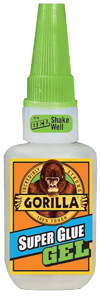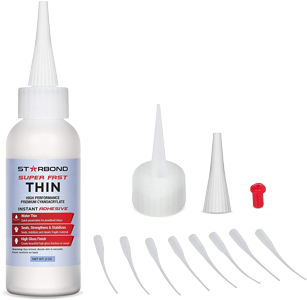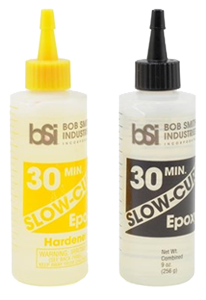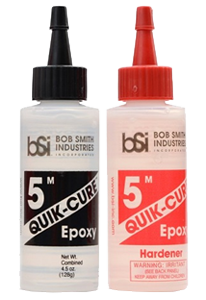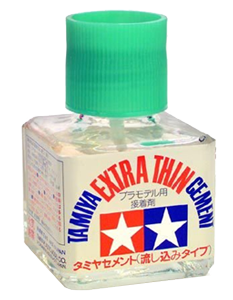SPRUEVERSE RESOURCES
Types of Model Glue / Cement
What kind of glue should I use for plastic models? What is the best glue to bond plastic to metal? These are common questions and this will come down to both glue type or preference. There are several types of glue that can be used for model building and customizing minis. Using the appropriate glue for the project will always give you the best results. Chemically these glues are all very different and they may even adhere two pieces very differently. Strength is another property of the different types of glue to consider. I will address each one of these things as well as the best uses for each type below.
PVA GLUE/WHITE GLUE
Polyvinyl Acetate is essentially white craft glue like Elmer’s. PVA is a water-based glue available in both domestic and commercial formulas. It isn’t really a strong adhesive but is definitely handy for certain instances. This kind of glue is generally best suited for landscaping work when building train scenes or large scale battle scenes, where it can be spread over a larger surface. While it has a weaker hold than other adhesives, it is easy-to-use and inexpensive for adding display details, like grass or stones. I use this glue often when building bases for displaying my mini where it can adhere to moss, small stones, and even mixed with sand for cool effects. It is also easy to remove if you do make a mistake. PVA dries to a clear to white opaque finish.
ALIPHATIC GLUE
Aliphatic Glue is basically wood glue also known as yellow glue which is very similar to PVA. The difference is it is made to set more rapidly as well as penetrate into porous materials for a stronger bond. It also more water-resistant and dries a bit harder to a cloudy buttery color.
CYANOACRYLATE (CA)
Cyanoacrylate which is often referred to as CA in scale-model communities is essentially the product known as Super Glue. CA is widely used by hobby modelers as it is very strong and widely available. It is great at finding just about anything including dissimilar materials like plastic to metal or metal to metal.
Its rapid set quality is also a desirable trait in certain instances where you may not have the ability to clamp the two pieces together or hold them for an extended period. CA is also available in a variety of consistencies ranging from watery thin to a thick gel-like consistency. The only thing you should keep in mind is while its strong bond can withstand pulling force against the bonded joint really well, torsion force where the bonded seam is forced in opposite directions does not hold well. It can also discolor certain plastics and will dry to a cloudy to white color.
EPOXY RESIN
This is a two-part bonding agent that consists of an adhesive and a hardener, epoxy resins are incredibly strong and will bind almost any two surfaces together. Before the application, the two agents are mixed together to activate the hardening process. It is important to note that drying time will generally be slower than super glue, but faster mixes are available and are usually just a higher ratio of the hardening agent. Using epoxy is definitely not as convenient and cleanup is certainly more involved which makes this method of gluing up models or miniature less common and only used out of necessity. When you need a strong bond, however, especially between dissimilar materials this is usually a go-to.
SOLVENT CEMENT
Solvent cement is probably one of the most popular choices adhesive among serious scale-model builders. Solvent cement is essentially a mixture of pure solvents like MEK, Butyl Acetate, and Acetone combined with various ratios of Styrene resins which is basically plastic. The thinnest solvent cement will contain very little Styrene resin and are mostly solvents, while the thicker consistencies will have a higher ratio of plastic resin. The interesting thing about solvent cement is how they bond plastics together. When applying the solvent cement to two pieces of plastic it will actually chemically melt the two surfaces and bonding them together which is essentially like welding two pieces of metal together. Its actually sometimes referred to as plastic welding. This method of bonding two pieces of plastic creates the strongest possible bond that will outlast any type of glue. This is also best for finishing work where you may need to sand or reshape material you won’t need to worry about weakening the joint like you would when using glue.
When searching for solvent cement for any project keep these two things in mind:
- Liquidity: This refers to how thin or thick the particular solvent cement will be. Going back to what I said above, this is altered by the ratio of plastic resin is mixed in with the solvent. The thicker the solvent cement the more resin in the mixture. This will also determine application since thinner solvents are usually applied by capillary action. Thicker solvents actually bond pieces with a resin membrane created by the solvent from the included resin.
- Solvent Hotness: The heat or hotness of solvent refers to how much the solvent will penetrate the plastic via a chemical reaction. Some solvents can actually melt a hole right through thinner pieces which can ruin your work. Thicker pieces may end up warping or become misshaped. It’s always good to try a bit on a test piece before using it on an actual model.
The final word on solvents, they work extremely well for plastic models but will not really work on other materials. You also need to take great caution when working with it around your plastic models as it can ruin your work. Solvents also dry relatively quickly so you need to work fast.
CANOPY GLUE
Canopy glue is a popular product among RC builders and scale model airplane builders who are often attaching clear plastic canopies to the aircraft. This glue will dry clear and not alter the plastic at all as to not cause any visual defects on the clear canopy. For the scale model builder you may not require the holding strength an RC builder may require. A while back I did a lot of research to try and determine how canopy glue was formulated but there wasn’t really a single glue type used by manufactures, some seemed to have a formula that resemble white glue, other seemed to use an acrylic based adhesive. In any case, I have found the adhesive E6000 to work extremely well and inexpensive while others really like Formula 560.
GLUE PREPARATION AND OTHER CONSIDERATIONS
Below are a few important things to consider when selecting the best model glue for the task. Beyond choosing the right glue for the job, with proper preparation and application, your end result will be very satisfactory and you can be left with the peace of mind that your glue work will hold up over time.
KNOW YOUR MATERIAL
When preparing to glue up your models or minis know what materials you will be working with and gluing up. Nothing is more frustrating than getting to the glue and assembly step only to realize you aren’t prepared with the right type of glue and the best plastic glue will not be the same as the best wood or metal glue. This is most often the case when you end up needing to glue dissimilar materials.
PREPPING YOUR MODELS AND MINIS
Before gluing up two pieces it is always a good idea to clean the surface you intend on gluing to remove any dust or oil that may interfere with the glue adhesion. Depending on the type of adhesive you are using, it may be a good idea to take a bit of sandpaper and lightly scuff the surface that the glue will adhere to which will provide a better surface for the glue to adhere to. Surface scuffing does not need to be down for solvent-based glue.
APPLYING HOBBY GLUE
Always try to use the manufacturer’s recommended method for applying the adhesive but don’t be afraid to experiment. For solvents, I always try to connect my pieces together then apply the solvent cement via capillary action in which I use a needle applicator to apply solvent along the seam which will suck the solvent in and do its work. You can also use a brush to apply to the surfaces then connect them.
For epoxy resins, I usually mix a small batch and then use something like a toothpick to apply the glue with a certain amount of precision. For something like super glue, the nozzles are great applicators.
GLUE CLEANUP
It is always a great idea to clean any excess glue off of the models before it sets for the simple fact that it is easier. One reason is that for super glue or epoxy resin, cleanup will usually utilize solvent-based chemicals which as addressed above, solvents can deform or melt the plastic. That said, some solvents are not as reactive toward plastic and can be used safely, albeit with caution.
SHOULD I PAINT OR GLUE FIRST?
This is both a matter of preference and a matter of what is being glued. Personally I try to glue everything up first, especially small pieces. This is because the glue will usually not adhere to paint and if it does the bond will not be as strong. Sometimes it does make sense to paint first and one example is if I am assembling miniatures in mass and different pieces are different colors. I will do this if I am sure I can ensure no paint we be applied to the surface I will be gluing. The final tip I have is to get yourself at least one bottle of each type of gluethat you are ready for just about anything your project will throw at you. It is always better to be over-prepared and I guarantee you will need just about every one of them if you are serious about the hobby. Also, LESS IS MORE when it comes to working with glue!
THE BEST GLUE FOR MODELS AND MINIATURES – QUICK REVIEWS
Below is a complete list of the best glue for both miniatures and scale models available. Since there are several types of glues used in the building of models and minis I have grouped the best choices in there respective glue type. These are the most reliable and popular choices among veteran builders
BEST PVA (WHITE) GLUE & ALIPHATIC (YELLOW) GLUE
TITEBOND ORIGINAL WOOD GLUE & GORILLA WOOD GLUE
Since there isn’t much variance with white glue there isn’t really one I recommend over another. Any high-quality white glue should do whether you buy it at a hobby shop or a craft store. As for wood glue or yellow glue, the best wood glue I have found is both Titebond Original Wood Glue and Gorilla Wood Glue. I have used them interchangeably for years with great success. I also have a family member who uses them in his cabinet shop and swears by them.
BEST SUPER GLUE FOR PLASTIC AND METAL MODELS
If you are looking for a great super glue product the choices below will work perfectly. I usually like to get both a gel base super glue and a thinner more liquid consistency. Having both will allow you to tackle a variety of uses. The gel type is great for build-up and filling minor gaps. Super glue is also usually your best bet for photo-etch.
GORILLA SUPER GLUE GEL REVIEW >
Gorilla Glue has become quite a popular choice for many of their glue products due to quality and durability. Their super glue gel is no exception and performs really well on scale models or minis. The gel is great for bonding dissimilar materials as it will build a nice amount of membrane to adhere two pieces to. This and ZAP-A-GAP has been my best super glue for miniatures and holds up well. If you have any trouble finding the Gorilla Glue gel, both Loctite Ultra Gel and ZAP-A-GAP are equally just as good. They both have about the same consistency as well. either of the two choice will be the best super glue for metal to plastic if you don’t have any epoxy on hand.
STARBOND SUPER FAST THIN REVIEW >
When I need a thin fast setting superglue Starbond is among the best. It sets incredibly fast and holds really well also. this glue is great for pieces that fit snuggle together and do not have any space or gaps to fill. The glue will hold two tightly fitting surfaces together incredibly well. When you aren’t having good luck with solvent cement, reach for the fast setting thin superglue. It should stick to just about anything and keep your pieces together with no issue. Just keep in mind super glue’s strength is in resisting pulling forces, not torsion.
BEST SUPER GLUE FOR PLASTIC AND METAL MODELS
If you need the absolute strongest bonds, especially when bonding metal to plastic, or plastic to fiberglass, or anything else really, epoxy resin is the only way to go. Epoxy is available in a variety of working times so pick one that will allow for enough working time before it sets or you can potentially ruin your pieces.
BOB SMITH INDUSTRIES CLEAR SLOW-CURE EPOXY >
If you need a strong bond, Bob Smith Slow-cure epoxy is among the best for scale model building. One thing I like about this epoxy is the quantity and bottle it is available in. A little epoxy will go a long way so you can just squeeze out the amount you need, mix it up and get to work. This epoxy will dry a clear color. This 4 oz bottles will provide a lot of use and with proper storage will last a long time. This is a great epoxy for metal car models or trains and planes that require bonding of plastic to metal. The bond will be strong and will adhere very well to just about any material if properly prepared. This slow cure will allow sufficient working time to get your pieces situated before setting and provide the strongest end result.
BOB SMITH INDUSTRIES QUIK-CURE EPOXY >
This epoxy is every bit as good as the slow cure Bob Smith above but with much shorter working time. When you need your two pieces to set up quickly this is the best option. One thing most people don’t know is that you do sacrifice some strength when using quick cure when compared to a slow curing epoxy.
BEST PLASTIC MODEL SOLVENT CEMENT
If you are working with plastic models, solvent-based epoxy is usually the best option you can use for bonding your plastic pieces together. The plastic weld it creates is the strongest and will outlast other adhesive products. The only thing you need to decide is the consistency of the solvent cement. Thicker will have more plastic resin in the solvent, thinner will be more solvent.
TAMIYA EXTRA THIN CEMENT >
There are many options out there for plastic cement but this is one product that is hands down above all the best plastic model cement. Even when compared to MEK, which is pure solvent, Tamiya Thin Cement still performs better. The fine tip brush makes application incredibly easy and it is also great to use with needle applicators for applying it along seems. There are definitely a few good solvent cements out there but Tamiya is just better in my and many other plastic model builders experience. If you prefer a thicker cement you can also try the Tamiya Plastic Cement which will also dry a little slower than the thin as well. If you have yet to try Tamiya’s Thin Cement it is highly recommended.
TESTORS CEMENT GLUE >
Testors Cement Glue is another great option that seems to be more readily available if you have trouble finding any of the other recommendations. If you prefer a thicker consistency to one more liquid, Testors Plastic Cement will fit your needs. This cement will join polystyrene to polystyrene and polystyrene to wood. It is also useful for repairing any items made of polystyrene or ABS plastics. It is usually a bit cheaper which makes it great for anyone doing a high volume of work. If you are fan of Testors but are looking for a thinner liquid cement check out Testors Liquid Cement.







